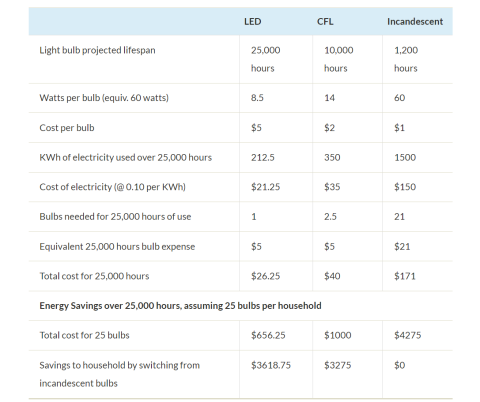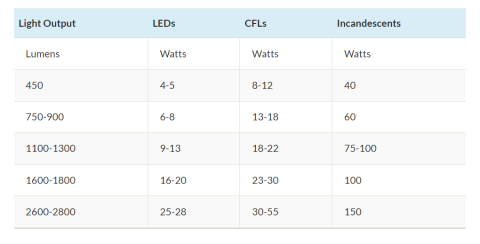
Lighting Tips that saves on Energy & Money

Switching to LED light bulbs can light up your home and save you some cash. LED stands for Light Emitting Diodes. 15% of our electric bill is due to lighting, and by switching to LED light bulbs, you could save hundreds of dollars a year.
Switching to LED light bulbs can help cut your lighting costs in half.
For the best energy efficient light bulbs, look for the ones that come with the Energy Star rating. LED's are the most energy efficient choice. While using 90% less energy, they also last 25 times longer than a traditional light bulb. LED light bulbs are cheaper than when they first became popular, but they still cost a bit more than regular incandescent light bulbs. LED's are an excellent choice for lighting because when they are on, they run on low energy while lighting the whole room. They also come in an assortment of colours.
For the best energy-efficient light bulbs, look for the ones that come with the Energy Star rating.

Lighting controls like Motion Sensors, Timers, or Dimmers can also help save energy and savings for your wallet. Lighting with dimmers can come with timers or be programmed to dim at certain times to your preference. For a dimmer switch for LED light bulbs, you must have specific LED light bulbs designed for dimming. Dimming a light bulb reduces the wattage, and this helps save energy.
Interior motion sensors are affordable to light the inside of your home and are easy to install. You can turn the lights on and off by entering and exiting the room. Interior motion sensor lights are usually small and are meant to illuminate smaller areas. Interior motion sensor lights can come in different styles. Depending on the area you would like to light up, here are three examples of the type they come in:
- The Motion Sensor Light Strip is the most used because of its decorative qualities and easy-to-install directions.
- The Motion Sensor Night Light functions like regular night lights. They have models that turn on only when you’re in the room, and these are popular for their use and energy-saving capabilities.
- The Motion Sensor Indoor Light Bulb has a built-in motion sensor. The sensor detects motion and turns on instantly, and this model goes straight into the light socket for easy installation.
Lighting controls like timers allow you to control the lighting in your home whether you are home or not. Timers can be set to make your home look like you’re there while out of town or just for the evening. Timers can help save energy and money, and many affordable and programmable timers are available on Amazon.
LED's vs CFL's vs Incandescent light bulbs:
LED lights quickly became popular over the traditional light bulb because of the energy and money savings. Developments in LED lights have improved over the years and now the Light Emitting Diodes are now ‘clustered’ to provide more light. Diffuser lenses allow the light to cover larger areas with light. Even the prices have dropped because of the advancements in technology.
Chart comparisons including Costs, Wattage, Light Output and Features:
Below are a few diagrams that show the difference in cost, wattage, light output and features of LED's, CFL's, and Incandescent light bulbs.



- The cost of electricity depends on where you live and how much you use.
- The average cost of an LED light bulb is typically around $5.00.
- LED's are claimed to last up to 25 years.
- Incandescent and CFL bulbs are more delicate and breakable than LED's.
- Defective LED's can fail, so most have a 2-year guarantee.
There are many different types of LED light bulbs to choose from. Some are available in either warm or cool lighting. You also have the choice of standard LED or dimmable LED's. Switching to LED's can save you energy, money, and they last much longer than traditional incandescent bulbs.
By: Tricia Cook, Content Navigator